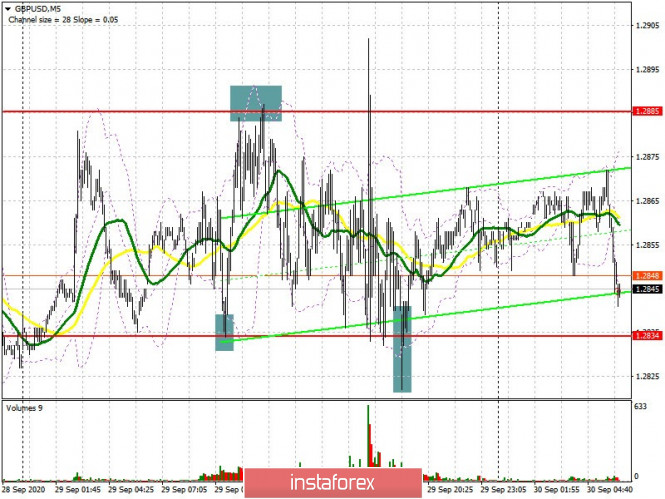To open long positions on GBP/USD, you need:
News that the British Parliament had approved the Internal Market Bill only led to a small spike in volatility, but the pair remains in a horizontal channel. Thanks to this, several more signals for entering the market appeared. Yesterday morning, a fairly good signal for buying the pound from the 1.2834 level appeared on the 5-minute chart. The pair increased to 1.2885 and the pound gained around 50 points. This was followed by short deals from 1.2885, which subsequently brought the pound back to 1.2834. Forming a false breakout at this level led to new long deals in GBP/USD, which is clearly seen on the chart.

The current situation has not changed in any way compared to the previous day. Buyers will wait for a breakout and settle above the resistance of 1.2885, which will form a new signal to enter long positions with the main goal of updating this week's high in the 1.2962 area, which is where I recommend taking profits. The 1.3089 level will be a distant target, but this is very difficult to achieve. UK GDP data for the second quarter will provide support, although we don't expect much from it. In case the pound falls, forming a false breakout at the 1.2834 level will be a signal to open long positions. In case bulls are not active in this range, it is better to postpone long deals until a larger low at 1.2766 has been updated, slightly above which the moving averages pass, playing on the side of the bulls. It is also possible to buy GBP/USD immediately on a rebound from the monthly low of 1.2689, counting on a correction of 30-40 points within the day.
The Commitment of Traders (COT) reports for September 22 did not record significant changes in the market, as everyone took a wait-and-see attitude and are watching how the economy will react to the next phase of growth in the incidence of COVID-19 and how the situation will develop further. Brexit. Most likely, the pressure on the pound will gradually return as the second wave of coronavirus spreads and the negotiations on a trade deal between the UK and the EU become more complicated, where there is not even a hint of a compromise between the parties. Short non-commercial positions slightly decreased from 41,508 to 40,523 during the reporting week. Long non-commercial positions also decreased from 43,801 to 43,487. As a result, the non-commercial net position remained practically unchanged at 2,964 against 2,293 weeks earlier.
To open short positions on GBP/USD, you need:
A lot will depend on how the EU reacts to the UK's draft Internal Market Bill, which was adopted yesterday. The pound will be under pressure if Brussels resorts to the promised political measures, allowing sellers to quickly regain control of the market. From a technical point of view, they need a breakout and have to settle below support at 1.2834. Testing this level on the reverse side forms a good entry point for short positions, which will quickly extinguish buyers' optimism and cause the first support level of 1.2766 to be updated, where I recommend taking profits. The 1.2689 level will be a distant target, testing it implies bringing back the bearish trend for the pound. If GBP/USD continues to grow, then it is best not to rush to sell, but wait for a false breakout to form in the resistance area of 1.2885. It is possible to sell the pair immediately on a rebound only when the weekly high has been updated in the 1.2962 area, counting on a correction of 30-40 points within the day.

Indicator signals:
Moving averages
Trading is carried out in the area of 30 and 50 moving averages, which indicates uncertainty regarding the direction.
Note: The period and prices of moving averages are considered by the author on the H1 hourly chart and differs from the general definition of the classic daily moving averages on the D1 daily chart.
Bollinger Bands
A breakout of the lower border of the indicator in the 1.2834 area will lead to a new wave of decline for the pound. The breakout of the upper border in the 1.2875 area will lead to a new wave of growth in the pound.
Description of indicators
- Moving average (moving average, determines the current trend by smoothing out volatility and noise). Period 50. It is marked in yellow on the chart.
- Moving average (moving average, determines the current trend by smoothing out volatility and noise). Period 30. It is marked in green on the chart.
- MACD indicator (Moving Average Convergence/Divergence — convergence/divergence of moving averages) Quick EMA period 12. Slow EMA period to 26. SMA period 9
- Bollinger Bands (Bollinger Bands). Period 20
- Non-commercial speculative traders, such as individual traders, hedge funds, and large institutions that use the futures market for speculative purposes and meet certain requirements.
- Long non-commercial positions represent the total long open position of non-commercial traders.
- Short non-commercial positions represent the total short open position of non-commercial traders.
- Total non-commercial net position is the difference between short and long positions of non-commercial traders.















 Download NOW!
Download NOW!
No comments:
Post a Comment